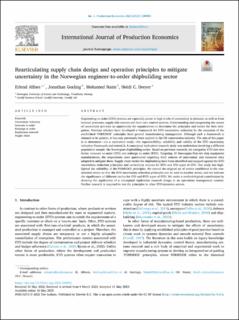| dc.contributor.author | Alfnes, Erlend | |
| dc.contributor.author | Gosling, Jonathan | |
| dc.contributor.author | Naim, Mohamed | |
| dc.contributor.author | Dreyer, Heidi Carin | |
| dc.date.accessioned | 2024-02-14T10:19:58Z | |
| dc.date.available | 2024-02-14T10:19:58Z | |
| dc.date.created | 2023-06-01T17:13:20Z | |
| dc.date.issued | 2023 | |
| dc.identifier.citation | International Journal of Production Economics. 2023, 262 . | en_US |
| dc.identifier.issn | 0925-5273 | |
| dc.identifier.uri | https://hdl.handle.net/11250/3117464 | |
| dc.description.abstract | Engineering-to-order (ETO) systems are especially prone to high levels of uncertainty in demand, as well as from internal processes, supply side sources and their own control systems. Understanding and categorising the causes of uncertainty provides an opportunity for organisations to determine the principles and tactics for their mitigation. Previous scholars have developed a framework for ETO uncertainty reduction by the extension of the established ‘FORRIDGE’ principles from general manufacturing management. Although such a framework is claimed to be generic, it has only previously been applied in the UK construction industry. The aim of this paper is to determine—via a replication study—the reproducibility, reliability and validity of the ETO uncertainty reduction framework and extend it. A conceptual replication research study was undertaken involving a different population sample: the Norwegian shipbuilding sector. Based on previous research, we categorise ETO into two forms: innovate to order (ITO) and redesign to order (RTO). Targeting 10 Norwegian first-tier ship equipment manufacturers, the respondents were questioned regarding their sources of uncertainty and measures they adopted to mitigate these. Supply chain tactics for shipbuilding have been identified and mapped against the ETO uncertainty reduction principles and uncertainty sources for RTO and ITO types of ETO. Our study has highlighted the reliability of the FORRIDGE principles. We extend the original set of tactics established in the construction sector so that the ETO uncertainty reduction principles can be used in another sector, and we indicate the significance of different tactics for ITO and RTO types of ETO. We make a methodological contribution by showing the application of a conceptual replication research design in an operations management context. Further research is required to test the principles in other ETO-intensive sectors. | en_US |
| dc.language.iso | eng | en_US |
| dc.publisher | Elsevier | en_US |
| dc.rights | Navngivelse 4.0 Internasjonal | * |
| dc.rights.uri | http://creativecommons.org/licenses/by/4.0/deed.no | * |
| dc.title | Rearticulating supply chain design and operation principles to mitigate uncertainty in the Norwegian engineer-to-order shipbuilding sector | en_US |
| dc.title.alternative | Rearticulating supply chain design and operation principles to mitigate uncertainty in the Norwegian engineer-to-order shipbuilding sector | en_US |
| dc.type | Peer reviewed | en_US |
| dc.type | Journal article | en_US |
| dc.description.version | publishedVersion | en_US |
| dc.source.pagenumber | 0 | en_US |
| dc.source.volume | 262 | en_US |
| dc.source.journal | International Journal of Production Economics | en_US |
| dc.identifier.doi | 10.1016/j.ijpe.2023.108903 | |
| dc.identifier.cristin | 2150981 | |
| cristin.ispublished | true | |
| cristin.fulltext | original | |
| cristin.qualitycode | 2 | |

